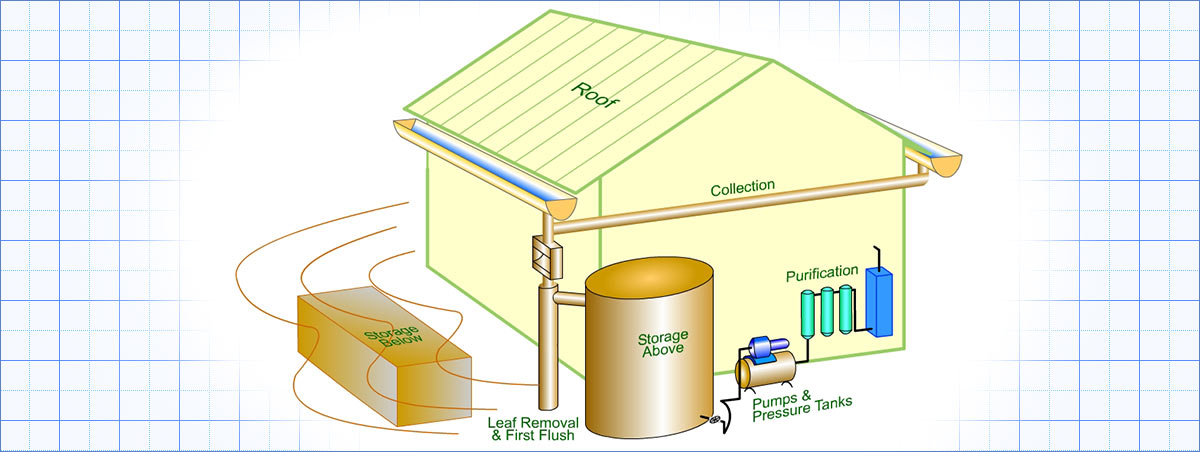
Components
We created a website that goes into great detail on each of these components. The Center for Rainwater Harvesting has a plethora of information, from gutter design, to tank selection, to how to adjust a pump pressure switch. Here is a general introduction to the necessary components:
Every rainwater harvesting system requires:
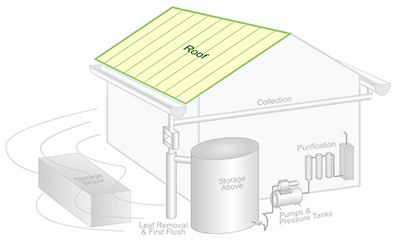 A Collection Surface – This is usually your roof. It really doesn’t make a lot of difference what your roof is made out of. The small amount of chemical and biological contamination of rainwater is from dust particles deposited on the roof by the wind and by bird and bat droppings. Regardless of your roof material, if you plan on using rainwater for drinking, bathing, or cooking, you will need to provide a robust filtration system that can remove contaminants. We offer several scientific reports on typical, Texas roof contaminants on our Center For Rainwater Harvesting web site here.
A Collection Surface – This is usually your roof. It really doesn’t make a lot of difference what your roof is made out of. The small amount of chemical and biological contamination of rainwater is from dust particles deposited on the roof by the wind and by bird and bat droppings. Regardless of your roof material, if you plan on using rainwater for drinking, bathing, or cooking, you will need to provide a robust filtration system that can remove contaminants. We offer several scientific reports on typical, Texas roof contaminants on our Center For Rainwater Harvesting web site here.
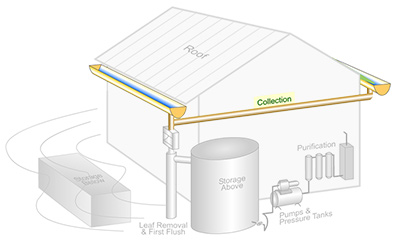 A Conveyance System – This is a system used to get the rainwater into the storage tank. It consists of gutters, downspouts, and pipes that convey the water to the tank. The conveying pipe can be either above ground, like an aqueduct, or below ground with a stub up at or inside the tank.. Regardless of how the pipes are run, the top eve of the tank will need to be at least 2 feet below the bottom of the lowest gutter. This allows room for a leaf eliminator and connection to a first flush described below. We can help you select the most efficient routing and pipe/gutter/downspout size to get your rainwater into your tank.
A Conveyance System – This is a system used to get the rainwater into the storage tank. It consists of gutters, downspouts, and pipes that convey the water to the tank. The conveying pipe can be either above ground, like an aqueduct, or below ground with a stub up at or inside the tank.. Regardless of how the pipes are run, the top eve of the tank will need to be at least 2 feet below the bottom of the lowest gutter. This allows room for a leaf eliminator and connection to a first flush described below. We can help you select the most efficient routing and pipe/gutter/downspout size to get your rainwater into your tank.
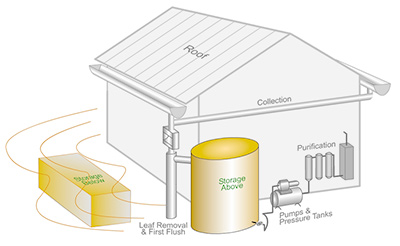 An Above or Below Ground Tank – Tanks are usually the most talked about item of a rainwater harvesting system even though they might not be the most expensive item. They can be made of plastic, galvanized steel, stainless steel, or cement. Whether you prefer an above or below ground tank, we can help you select the most cost effective and longest lasting tank for your application. Our galvanized tanks come with a 20 year leak guarantee.
An Above or Below Ground Tank – Tanks are usually the most talked about item of a rainwater harvesting system even though they might not be the most expensive item. They can be made of plastic, galvanized steel, stainless steel, or cement. Whether you prefer an above or below ground tank, we can help you select the most cost effective and longest lasting tank for your application. Our galvanized tanks come with a 20 year leak guarantee.
Sizing the tank can seem daunting, but we can walk you through how it’s done using our interactive tank sizing program that you can find here.
 A Means of Pressurizing the Water – For some irrigation applications, elevation of the tank and gravity can be used to distribute rainwater thus saving electricity. That is what we use in our work in remote villages all over the world. However, you will need a good quality, properly sized pump for potable and drip/broadcast irrigation systems. We can size and supply a very high quality pump for any application.
A Means of Pressurizing the Water – For some irrigation applications, elevation of the tank and gravity can be used to distribute rainwater thus saving electricity. That is what we use in our work in remote villages all over the world. However, you will need a good quality, properly sized pump for potable and drip/broadcast irrigation systems. We can size and supply a very high quality pump for any application.
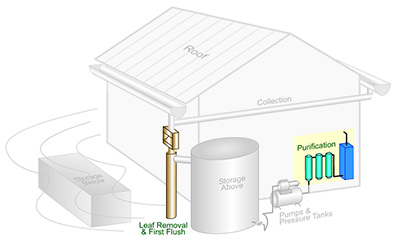 A Filtration System – Not all filtration systems are made the same! If you are simply using the rainwater for irrigation, all you need is a sediment filter or two to keep the emitters from plugging.
A Filtration System – Not all filtration systems are made the same! If you are simply using the rainwater for irrigation, all you need is a sediment filter or two to keep the emitters from plugging.
If you are going to drink the water you will need a sediment filter, followed by chemical filters sized and selected for your roof material and expected contaminants, followed by a high quality ultraviolet filter to remove the biological contaminants. We custom make robust and easily maintained filter configurations out of materials that are easy for you to replace as needed. Your water will be softer and cleaner than your well or City water. It will taste better and be better for your body, skin, and hair. You’ll love it.